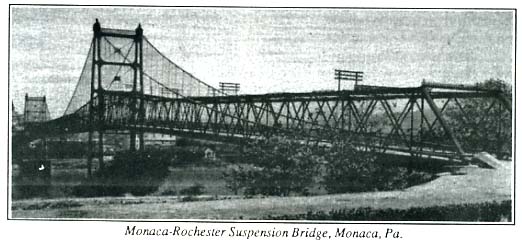
Click Here to Return to Milestones
This account of early Ohio River crossings appeared in the program distributed at the formal opening of the Monaca-Rochester Bridge, in 1930. J.P. Leaf was a noted Beaver County engineer and historian.
One of the important Indian trails crossed the Ohio near the mouth of the Beaver, going north to Lake Erie, Canada and the great Northwest.
This Indian highway was followed by trappers and traders and by the army to conquer the red man, and later by the great hosts of immigrants and settlers to the Ohio country and the far west, as the Mississippi valley was then called.
As early as 1795 a famous French explorer records stopping with the ferryman at the mouth of the Beaver.
The writer's grandfather used to tell of the rescue in 18 15 of Miss Lacock, who thoughtlessly allowed her horse to drink from
the stream while being ferried across the river, the horse losing his balance and tumbling into the water with his rider.
The ferry boat "Messenger" was in service from 1833 to 1847, and possibly much longer, later the "W. C. Gray" and "Mary C. Campbell" conveyed the citizens of the South Side back and forth to the railroad and markets until 1877 when the P. & L. E. R. R. gave this important part of our country a railroad outlet.
The next, and very important step connecting the inhabitants and factories of the north and south halves of the great "State of Beaver" was the building of Ohio River Suspension Bridge between Rochester and Monaca in 1896. This was a great event and a step forward in the progress of Western Pennsylvania, and did much to develop our great county and especially the towns of Rochester and Monaca.

This was the first passenger bridge to span the Ohio River between Pittsburgh and Wheeling, and for many years the only highway bridge over the Ohio in Pennsylvania. This bridge was the first free bridge over the entire Ohio River, and today is one of three free bridges over this great river, all of them being in Pennsylvania, and two in Beaver County.
A measure of the importance of this bridge is that it carries two state highways, Nos. 51 and 18, as well as the main boulevard on the south bank of the Ohio from Pittsburgh to the Northwest.
When originally built this was among the longest bridges in the country; its center span of 800 feet being only ten feet shorter than the entire length of the great Niagara Suspension Bridge. This channel span is equalled by only two bridges on the Ohio River, and is somewhat longer than the channel span of the new bridge about to be opened. The suspension tower piers are built upon a grillage composed of three layers of 12x 12 timbers, which rest upon pilings driven three feet apart, below the river bed. Upon the piles and grillage the stone piers, with solid concrete centers rest. They are still in excellent shape, after supporting the bridge with its constant stream of travellers for thirty-four years.
The cables are as good as the day they were completed. The bridge has been repaired from time to time and kept in good shape for travel, and is carrying a greater tonnage every day than its progressive builders ever dreamed. There are over 10,000 automobiles crossing this bridge every day, and while 14 tons was the live load used in designing this bridge, concrete mixers, steam shovels, and trucks loaded with steel weighing over 20 tons cross frequently.
Its great test since the opening parade, making the bridge free, was the parade when the Monaca football team carried off the county honors. From Rochester this immense throng of people filled the bridge its entire length with a solid mass of marchers. People walking make the heaviest load possible on a bridge, making a much greater total load than a bridge filled with loaded trucks.
This bridge, like all American bridges, has been outgrown by modem travel and become very expensive to keep in repair, so the County Commissioners wisely decided it would be better to build a new bridge than to spend $200,000 to put the suspension bridge in shape to care for the increasing travel demands.
Thus we come today to celebrate the opening of a fine new cantilever bridge, whose piers rest on solid rock, and designed to carry loads of 22 tons without a tremble. You will hear of its good points and see its beauties, for today this new bridge takes the place of the suspension bridge that has carried safely a generation of citizens. Its promoters and builders deserve our praise and gratitude for their foresight, and a large contribution to the welfare and prosperity of this great community.
Within 90 days from today this veteran bridge will pass. Perhaps its iron will go into automobiles to carry us across the fine new structure. The old piers will be removed by the U.S. Government Engineers and the stone used to protect several dams on the rivers of this district.
Our beautiful Ohio, with its teeming commerce and life giving waters will know it no more.